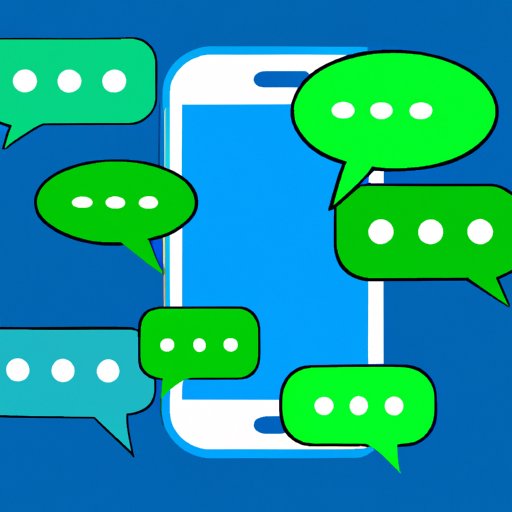Introduction
If you own an iPhone, you’ve likely noticed that the color of your messaging bubbles can sometimes be blue, and other times green. For some people, this might not seem like a big deal. But for others, the color of their messaging bubbles can have a significant impact on their emotions and social status. In this article, we’ll explore why iPhone messages turn green, the psychological and technical reasons behind this, the significance of blue versus green messaging bubbles in communication, and how the color of messaging bubbles might affect your social status or relationships.
The Psychological Impact of Green Messaging Bubbles on iPhone Owners
Believe it or not, the color of your messaging bubbles can have a psychological impact on how you feel. According to some iPhone owners, receiving a green message bubble instead of a blue one can feel like a downgrade. Some people view green messaging bubbles as undesirable or uncool, and receiving one can make you feel like you’re not part of the “in crowd.”
But why does the color of a messaging bubble matter so much? According to color psychology, green is often associated with negative emotions such as envy or jealousy. Additionally, green is not as commonly used as blue, which may make it feel less familiar or comforting to some people.
Psychologists have also found that people associate certain colors with certain emotions. For example, blue is often associated with calmness, trustworthiness, and professionalism. In contrast, green is associated with growth, envy, and sometimes sickness. These associations might explain why some iPhone users prefer blue messaging bubbles to green ones.
The Technical Reason Behind Green Messaging Bubbles on iPhones
So, why do some messages turn green instead of blue? The answer lies in how iMessage and SMS/MMS work on iPhones. iMessage is an Apple messaging service that allows iPhone, iPad, and Mac users to send texts, photos, and videos to other Apple users. When you send an iMessage to another iPhone user, your message appears as a blue bubble. If your message turns green, it means that your message was sent as an SMS/MMS instead of an iMessage.
SMS stands for Short Message Service, while MMS stands for Multimedia Messaging Service. Unlike iMessage, which uses a mobile data connection to send messages, SMS/MMS uses your cellular network to send messages. This means that if you’re in an area with poor or no data coverage, your iPhone will automatically send your message as an SMS/MMS instead of an iMessage.
Another reason why messages may turn green is that the person you’re messaging doesn’t have an iPhone or other Apple device. If you send a message to an Android user, for example, it will be sent as an SMS/MMS.
The Significance of Blue Versus Green Messaging Bubbles in Communication
While the color of messaging bubbles might seem like a superficial issue, it can actually have a significant impact on the tone and context of a conversation. For example, if you’re discussing something serious or important, seeing a green bubble might make the conversation feel less urgent or professional. On the other hand, if you’re having a casual conversation with friends, the color of messaging bubbles might not matter as much.
In some cases, the color of messaging bubbles might be indicative of whether or not someone is reachable. If someone’s messages are always blue, it might signal that they have a strong internet connection and are available to chat at any time. On the other hand, if someone’s messages are frequently green, it might indicate that they’re often in areas with poor data coverage or don’t have an iPhone.
The Universal Issue of Mixed Messaging Platforms in Text Communication
One of the biggest challenges of text communication is that messaging platforms can vary across devices and operating systems. For example, if you’re texting with someone who has an Android phone, you might not be able to use iMessage and instead have to rely on SMS/MMS. This could result in communication issues, such as delayed messages or formatting errors.
To deal with this issue, some messaging apps such as WhatsApp and Facebook Messenger have become more popular because they allow users to message across different platforms.
How the Color of Your Messaging Bubbles Can Affect Your Social Status or Relationships
Believe it or not, some people might judge you based on the color of your messaging bubbles. For example, if you’re always sending messages with green bubbles, it might signal to others that you’re not an iPhone user or that you don’t have a strong internet connection. This could potentially affect your social status or relationships.
Additionally, some users might prefer messaging with others who have blue bubbles because it indicates that they have access to iMessage and a strong internet connection. This could be especially important in professional contexts where communication needs to be timely and efficient.
Conclusion
The color of your messaging bubbles might seem like a trivial issue at first, but it can actually have a significant impact on your emotions, communication, and social status. While there’s no clear-cut solution to the problem of mixed messaging platforms, being aware of the technical and psychological reasons behind green messaging bubbles can help you navigate these communication challenges more effectively.
Ultimately, the color of messaging bubbles should not be a major factor in your communication or relationships. While it’s natural to have preferences, it’s important to prioritize the content and context of your messages over the color of the bubbles themselves.
